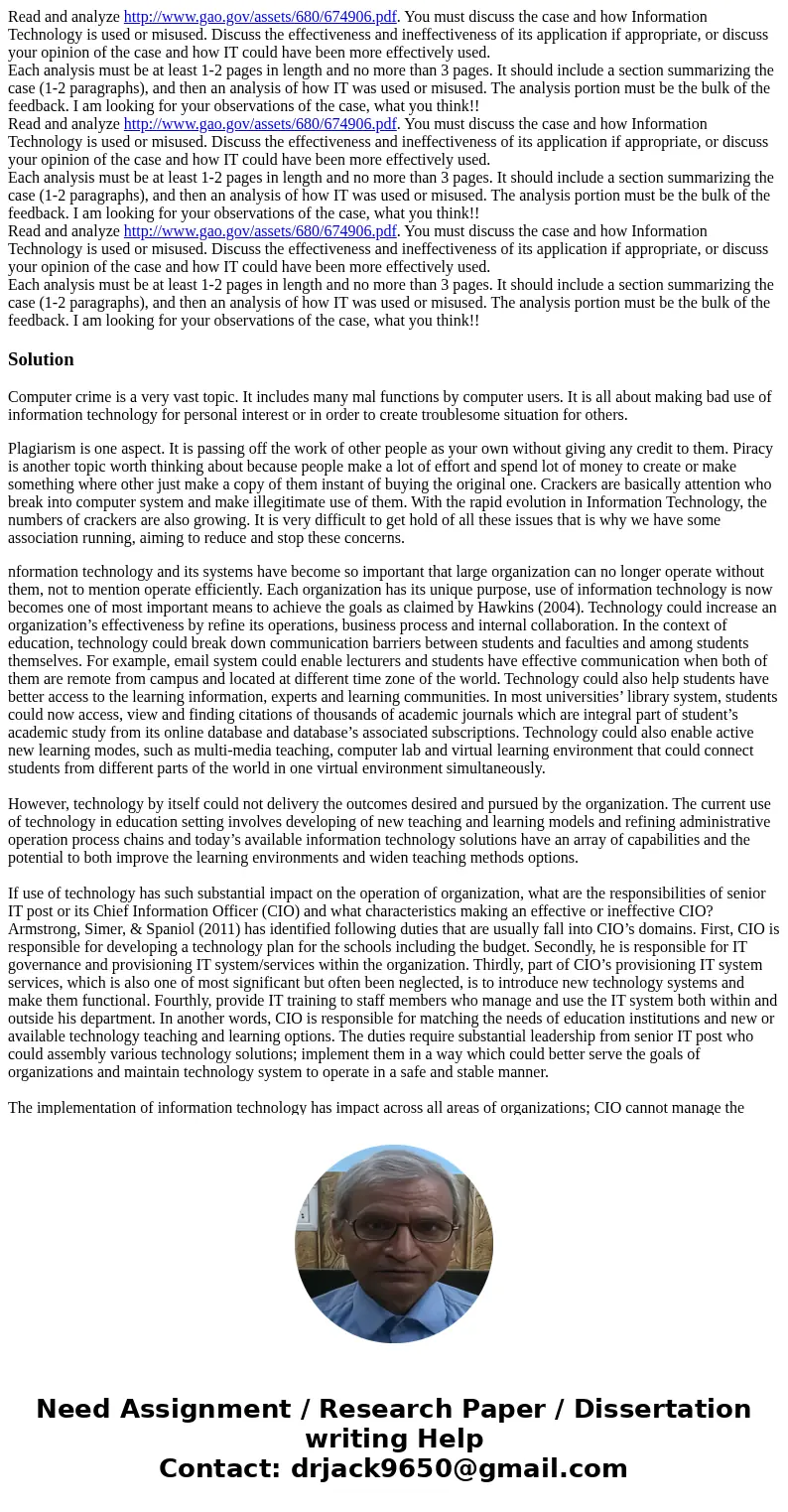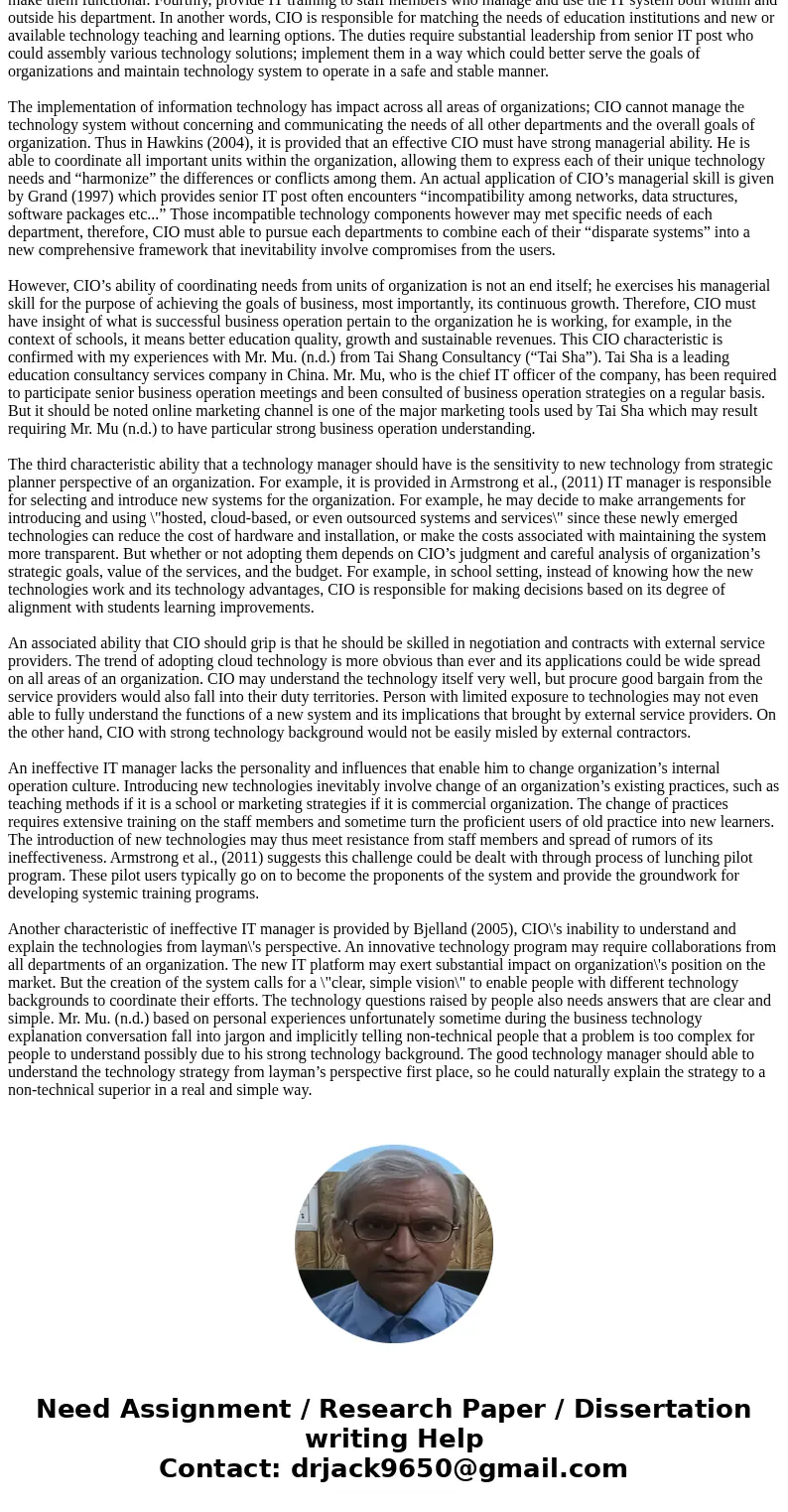Read and analyze httpwwwgaogovassets680674906pdf You must di
Solution
Computer crime is a very vast topic. It includes many mal functions by computer users. It is all about making bad use of information technology for personal interest or in order to create troublesome situation for others.
Plagiarism is one aspect. It is passing off the work of other people as your own without giving any credit to them. Piracy is another topic worth thinking about because people make a lot of effort and spend lot of money to create or make something where other just make a copy of them instant of buying the original one. Crackers are basically attention who break into computer system and make illegitimate use of them. With the rapid evolution in Information Technology, the numbers of crackers are also growing. It is very difficult to get hold of all these issues that is why we have some association running, aiming to reduce and stop these concerns.
nformation technology and its systems have become so important that large organization can no longer operate without them, not to mention operate efficiently. Each organization has its unique purpose, use of information technology is now becomes one of most important means to achieve the goals as claimed by Hawkins (2004). Technology could increase an organization’s effectiveness by refine its operations, business process and internal collaboration. In the context of education, technology could break down communication barriers between students and faculties and among students themselves. For example, email system could enable lecturers and students have effective communication when both of them are remote from campus and located at different time zone of the world. Technology could also help students have better access to the learning information, experts and learning communities. In most universities’ library system, students could now access, view and finding citations of thousands of academic journals which are integral part of student’s academic study from its online database and database’s associated subscriptions. Technology could also enable active new learning modes, such as multi-media teaching, computer lab and virtual learning environment that could connect students from different parts of the world in one virtual environment simultaneously.
However, technology by itself could not delivery the outcomes desired and pursued by the organization. The current use of technology in education setting involves developing of new teaching and learning models and refining administrative operation process chains and today’s available information technology solutions have an array of capabilities and the potential to both improve the learning environments and widen teaching methods options.
If use of technology has such substantial impact on the operation of organization, what are the responsibilities of senior IT post or its Chief Information Officer (CIO) and what characteristics making an effective or ineffective CIO? Armstrong, Simer, & Spaniol (2011) has identified following duties that are usually fall into CIO’s domains. First, CIO is responsible for developing a technology plan for the schools including the budget. Secondly, he is responsible for IT governance and provisioning IT system/services within the organization. Thirdly, part of CIO’s provisioning IT system services, which is also one of most significant but often been neglected, is to introduce new technology systems and make them functional. Fourthly, provide IT training to staff members who manage and use the IT system both within and outside his department. In another words, CIO is responsible for matching the needs of education institutions and new or available technology teaching and learning options. The duties require substantial leadership from senior IT post who could assembly various technology solutions; implement them in a way which could better serve the goals of organizations and maintain technology system to operate in a safe and stable manner.
The implementation of information technology has impact across all areas of organizations; CIO cannot manage the technology system without concerning and communicating the needs of all other departments and the overall goals of organization. Thus in Hawkins (2004), it is provided that an effective CIO must have strong managerial ability. He is able to coordinate all important units within the organization, allowing them to express each of their unique technology needs and “harmonize” the differences or conflicts among them. An actual application of CIO’s managerial skill is given by Grand (1997) which provides senior IT post often encounters “incompatibility among networks, data structures, software packages etc...” Those incompatible technology components however may met specific needs of each department, therefore, CIO must able to pursue each departments to combine each of their “disparate systems” into a new comprehensive framework that inevitability involve compromises from the users.
However, CIO’s ability of coordinating needs from units of organization is not an end itself; he exercises his managerial skill for the purpose of achieving the goals of business, most importantly, its continuous growth. Therefore, CIO must have insight of what is successful business operation pertain to the organization he is working, for example, in the context of schools, it means better education quality, growth and sustainable revenues. This CIO characteristic is confirmed with my experiences with Mr. Mu. (n.d.) from Tai Shang Consultancy (“Tai Sha”). Tai Sha is a leading education consultancy services company in China. Mr. Mu, who is the chief IT officer of the company, has been required to participate senior business operation meetings and been consulted of business operation strategies on a regular basis. But it should be noted online marketing channel is one of the major marketing tools used by Tai Sha which may result requiring Mr. Mu (n.d.) to have particular strong business operation understanding.
The third characteristic ability that a technology manager should have is the sensitivity to new technology from strategic planner perspective of an organization. For example, it is provided in Armstrong et al., (2011) IT manager is responsible for selecting and introduce new systems for the organization. For example, he may decide to make arrangements for introducing and using \"hosted, cloud-based, or even outsourced systems and services\" since these newly emerged technologies can reduce the cost of hardware and installation, or make the costs associated with maintaining the system more transparent. But whether or not adopting them depends on CIO’s judgment and careful analysis of organization’s strategic goals, value of the services, and the budget. For example, in school setting, instead of knowing how the new technologies work and its technology advantages, CIO is responsible for making decisions based on its degree of alignment with students learning improvements.
An associated ability that CIO should grip is that he should be skilled in negotiation and contracts with external service providers. The trend of adopting cloud technology is more obvious than ever and its applications could be wide spread on all areas of an organization. CIO may understand the technology itself very well, but procure good bargain from the service providers would also fall into their duty territories. Person with limited exposure to technologies may not even able to fully understand the functions of a new system and its implications that brought by external service providers. On the other hand, CIO with strong technology background would not be easily misled by external contractors.
An ineffective IT manager lacks the personality and influences that enable him to change organization’s internal operation culture. Introducing new technologies inevitably involve change of an organization’s existing practices, such as teaching methods if it is a school or marketing strategies if it is commercial organization. The change of practices requires extensive training on the staff members and sometime turn the proficient users of old practice into new learners. The introduction of new technologies may thus meet resistance from staff members and spread of rumors of its ineffectiveness. Armstrong et al., (2011) suggests this challenge could be dealt with through process of lunching pilot program. These pilot users typically go on to become the proponents of the system and provide the groundwork for developing systemic training programs.
Another characteristic of ineffective IT manager is provided by Bjelland (2005), CIO\'s inability to understand and explain the technologies from layman\'s perspective. An innovative technology program may require collaborations from all departments of an organization. The new IT platform may exert substantial impact on organization\'s position on the market. But the creation of the system calls for a \"clear, simple vision\" to enable people with different technology backgrounds to coordinate their efforts. The technology questions raised by people also needs answers that are clear and simple. Mr. Mu. (n.d.) based on personal experiences unfortunately sometime during the business technology explanation conversation fall into jargon and implicitly telling non-technical people that a problem is too complex for people to understand possibly due to his strong technology background. The good technology manager should able to understand the technology strategy from layman’s perspective first place, so he could naturally explain the strategy to a non-technical superior in a real and simple way.


 Homework Sourse
Homework Sourse